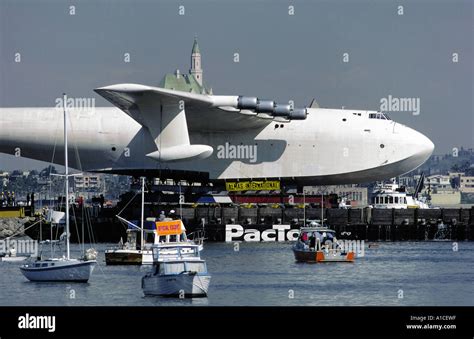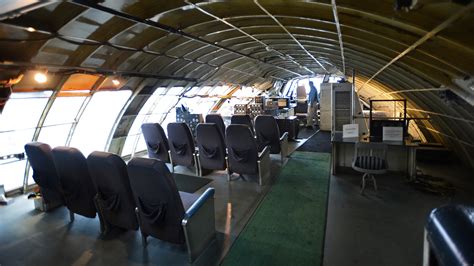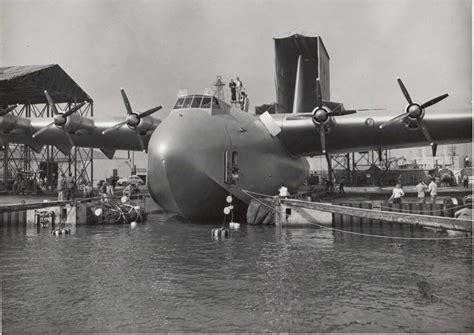The Hughes Flying Boat, more commonly known as the Spruce Goose, was a monumental achievement in aviation history, embodying the innovative spirit and perseverance of its creator, Howard Hughes. Constructed during World War II, this gigantic flying boat was designed to transport troops and equipment over long distances, capitalizing on the concept of seaplanes to circumvent the limitations of traditional runways. The project's significance extends beyond its technical accomplishments, reflecting the era's technological ambitions and the visionary yet often controversial figure behind it.
Howard Hughes, a successful filmmaker, entrepreneur, and aviation enthusiast, had a profound impact on the development of the Spruce Goose. His involvement in the project was not merely as a financier but as a driving force, overseeing every detail from design to construction. The aircraft's conception was a response to the U.S. government's call for a transport plane that could carry large payloads across the Atlantic Ocean without the need for runways, thereby avoiding the risks associated with conventional airfields. Hughes Aircraft Company, founded by Hughes, took on this challenge, with the project officially commencing in 1942.
Key Points
- The Spruce Goose was designed to carry 66 troops or a 35-ton payload, emphasizing its role as a strategic transport vehicle.
- Constructed primarily from birch, not spruce, due to wartime material shortages, the aircraft's name was a misnomer.
- The project was plagued by delays, criticisms, and funding issues, reflecting the complexities and risks inherent in pioneering aviation technology.
- Despite its first and only flight on November 2, 1947, the Spruce Goose never entered service, symbolizing both the triumph of innovative engineering and the challenges of translating vision into practical reality.
- Today, the Spruce Goose is on display at the Evergreen Aviation & Space Museum in McMinnville, Oregon, serving as a testament to the ingenuity and perseverance of Howard Hughes and his team.
Design and Construction

The Spruce Goose, officially known as the H-4 Hercules, was an impressive aircraft, measuring 218 feet 8 inches in length and 79 feet 4 inches in height, with a wingspan of 320 feet 11 inches. Its massive size and the materials used in its construction were novel for the time, with birch being the primary material due to the wartime shortage of aluminum and other critical metals. The design included eight radial engines, each producing 3,000 horsepower, and a complex system of flaps and spoilers to manage its vast wingspan during flight. Despite its enormous size, the aircraft was remarkably lightweight, thanks to the innovative use of materials and construction techniques.
Flight and Legacy
The first and only flight of the Spruce Goose took place on November 2, 1947, with Howard Hughes at the controls. The aircraft lifted off the water and flew for approximately one mile at an altitude of 70 feet, demonstrating its capability to fly, albeit briefly. This flight, while historic, was not without controversy, as it came after years of development and millions of dollars in investment, raising questions about the project’s practicality and the allocation of wartime resources. Despite its promise, the Spruce Goose never entered operational service, becoming instead a symbol of both the genius and the extravagance of its creator.
| Specification | Value |
|---|---|
| Crew | 3 |
| Length | 218 feet 8 inches |
| Wingspan | 320 feet 11 inches |
| Height | 79 feet 4 inches |
| Empty Weight | 265,000 pounds |
| Gross Weight | 400,000 pounds |
| Powerplant | 8 × Pratt & Whitney R-4360 radial engines, 3,000 hp each |

Controversies and Criticisms

Throughout its development, the Spruce Goose project was marred by controversy, criticism, and political scrutiny. The enormous costs, coupled with delays and the perception that the project was a vanity endeavor by Hughes, led to Senate hearings and public skepticism. The project’s wartime context, with the U.S. government funding various secret and experimental projects, further complicated its public image and operational feasibility. Despite these challenges, the project pushed the boundaries of aviation engineering, contributing to future advancements in materials science, aerodynamics, and large-scale aircraft design.
Historical Context and Evolution
The development of the Spruce Goose was deeply intertwined with the historical context of World War II, reflecting the urgent need for innovative solutions to military logistics and transport challenges. The project’s emphasis on seaplane technology, intended to bypass the limitations of traditional airfields, represented a strategic response to the threats and opportunities of the time. While the Spruce Goose itself did not become an operational asset during the war, its legacy influences the design and development of subsequent large aircraft, including military transports and commercial airliners, demonstrating the enduring impact of visionary projects on the evolution of technology.
What was the primary purpose of the Spruce Goose?
+The primary purpose of the Spruce Goose was to serve as a transport aircraft capable of carrying large payloads, including troops and equipment, without the need for traditional runways, thus providing strategic flexibility during wartime.
Why was the project named the Spruce Goose?
+The project was named the Spruce Goose due to a misunderstanding about its primary construction material. Although it was actually made from birch, the name stuck, becoming an enduring part of its legend and public image.
What is the current status of the Spruce Goose?
+The Spruce Goose is currently on display at the Evergreen Aviation & Space Museum in McMinnville, Oregon, serving as a historical artifact and educational exhibit that showcases the ingenuity and ambition of its creator and the era in which it was built.



